Those who know me will most likely already have heard that this spring, I bought an Allen church organ - one of the very earliest digital organs made. (A similar one is in the Smithsonian; the model is that significant to the history of organs.)
Well, let's just say that it's a very fine instrument, but showing its age in several small ways. Like any engineer, I have the attitude: "If you don't like the world, modify it!" So I've got a big fun project to keep me occupied for the summer. (In whatever spare time I'm not spending in trying to learn to play the thing!). So let's have a look at what I'm looking to do.
One particular period feature of the organ is that the alterable voices (wavetables in the early 1970's were novel technology!) are programmed with IBM cards, inserted manually into a little slot to the right of the manuals. Each card has a binary encoding of the waveform produced by a specific style of organ pipe.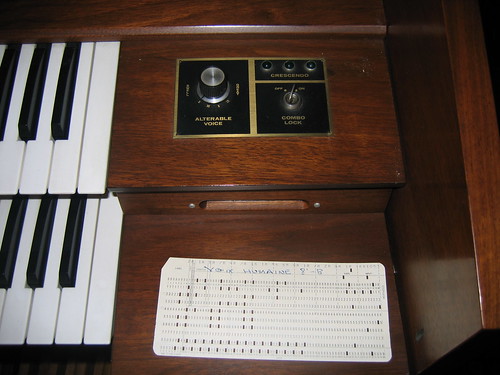
I have dozens if not hundreds of cards for it, and they're getting rather fragile. 35 years ago, they weren't making punch cards to last for the ages. Moreover, the card reader has acted up twice for me. The first time, it was just dust and dirt obstructing part of it, and a can of air repaired it nicely. More recently, it's just quit. Time to investigate.
Getting to the card reader was a fairly simple matter once I found the two screws (one on each side) that hold the lid of the keydesk in place. The lid then swings up. If you try this, make sure you latch the music desk in the 'down' position first!
Once the lid is up, the stopboard is held in with two screws, one under the Pedal stoptabs and one under the Great.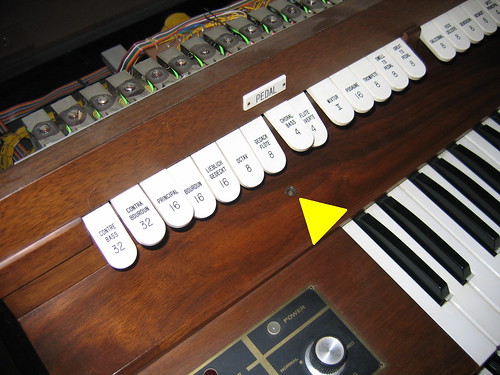
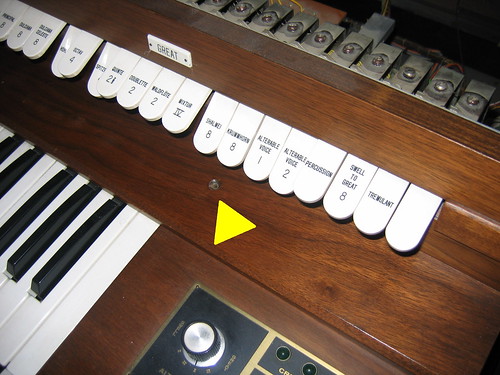
With these screws out, it swings up out of the way. 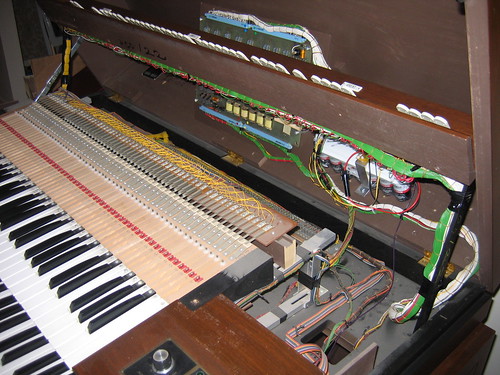
Now the Swell manual simply lifts up: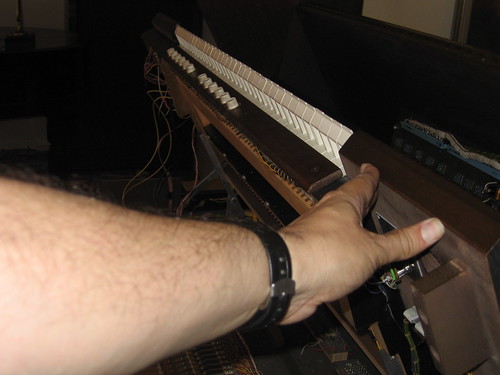
Lifting the Swell manual reveals the card reader underneath it. The reader is held in with a card-edge connector and four screws. A quick test with the power switch reveals that one of the row of incandescent lamps on the top of the reader is burnt out.
Well, obviously that is one piece of technology that can be upgraded. Put LED's in there instead, and never worry about another burnout. But now a light bulb (or perhaps an LED, this is the twenty-first century) goes on over Kevin's head. This little lamp bar, easily removed, is the key to eliminating the deteriorating IBM cards without any electrical modifications to the organ. Pull out the light bar, and replace it with an LED bar with the LED's sequenced by a microcontroller as if the card was being inserted and withdrawn. And thus is born the Allen Organ Card Reader Upgrade.
Few good ideas are truly new. A little bit of trolling through the search engines shows that this idea is the subject of U.S. Patent 4,416,177. Fortunately, that patent is expired, and so there should be freedom to operate here. I'm essentially replicating exactly the device shown there, only with modern components.

3 comments:
Hi greeat reading your post
Hey! It's GREAT to see ANOTHER (as in THE only other haha) Allen Organ enthusiast! If you don't mind me asking...What kind of ballpark price did you offer for that beautiful piece of equipment? I have an extra in GREAT and excellent shape, and she sounds as beautiful as can be?
Clicking on my name actually takes you to a BAD picture of the one I speak of!
Post a Comment